An Insider’s Look at Trail Grooming
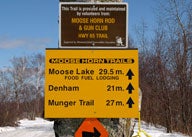
There's more to good trails than a devoted groomer operator
Back in the 1970s when I first started riding snowmobiles in upstate New York, no one thought about groomed or marked trails. You went out and rode just about anywhere. The most formal thing you did in regards to a “trail” was ask a farmer if you could drop a section of fence to make a passage to a section of trail you needed. All this with the promise you would put that section of fence back up in the spring when winter and the riding season were over! Ah yes, those were the days and life was so simple! I’m sure we all have stories like this from back “in the day.” However, as we all know, as the sport of snowmobiling advanced so has the complications of trail access, trail marking and trail grooming. So did you ever wonder how we got from there to where we are today?
Trail History
As the sport of snowmobiling exploded back in the late 1960s and into the 1970s, problems with trail access and use became major issues. Not everyone had the same “passion” for our sport, especially those individuals who had snowmobilers ripping past their houses and turning their TV’s into fuzzy screens (Remember those unshielded plug wires on the old sleds?) or, even worse, waking them out of a sound sleep at 2am….NOT good impressions for the snowmobile community!
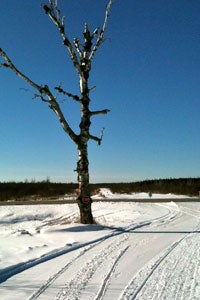 Trails can be lonely, solitary places at groomer speeds.
Trails can be lonely, solitary places at groomer speeds.If the sport of snowmobiling was to advance and prosper, things had to change. As we all know snowmobilers are a resilient and creative lot. Organized snowmobiling first got started on the local level with the formation of local snowmobile clubs, first on a social level for family get-togethers and then second on a more political (i.e. trail access, trail grooming, etc.) level as the sport advanced.
By 1971 snowmobile trail development and trail grooming was being ramped up in Canada. Ski-Doo’s Laurent Beaudoin (son-in-law of Ski-Doo inventor J-Armand Bombardier) had a vision for the future. It was like the chicken and the egg. He realized that if there were no trails to ride on for the future, snowmobiling had no future! You could have all the different snowmobiles in the world (at the time 100+ manufacturers were bringing snowmobiles to market) but if you had no trails to ride them on it was all for naught. Ski-Doo introduced “Sno-Plan,” which not only put into gear a plan to develop a system of snowmobile trails in Quebec but it also sold more snowmobiles for Bombardier and Ski-Doo.
The way “Sno-Plan” worked was pretty simple. Buy a SV200 groomer (believe it or not there are still SV200’s running around out there grooming trails today!) and Bombardier would throw in a Ski-Doo Elan to use as the club wished. Most of these Elans were raffled off to offset the cost of the SV200 or to develop new trails. Everybody was a winner! As the sport of snowmobiling progressed in North America, provincial and state level organizations evolved to the point they are at today, being the voice of the state and local snowmobile community. In snowbelt areas, provincial and state associations work hand in hand with state and federal government for trail access, paid grooming contracts to maintain trails, and, in many cases grant funds (either state or federal) to purchase capital grooming equipment. All these factors lead up to those beautiful snowmobile trails we all love to ride in the wintertime!
How it All Gets Done
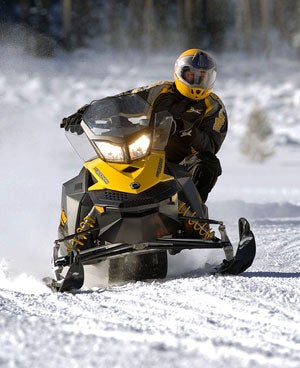 Remember that you enjoy the freedom of the sport’s trails because of the grooming and maintenance efforts of volunteers at clubs and associations.
Remember that you enjoy the freedom of the sport’s trails because of the grooming and maintenance efforts of volunteers at clubs and associations.Grooming snowmobile trails is big business. That’s right, it is a business…a very expensive business. Just to give you a quick snapshot, in the Snowbelt of North America there are around 2,600 pieces of equipment (i.e. 7+ feet wide and larger) out there making those trails nice and smooth for everyone to ride on. This doesn’t include all those smaller (i.e. Less than 6 feet wide) units that are out there dragging those smaller feeder trails. It’s a huge undertaking that so many of us just take for granted. Another quick fact, the average cost of a NEW piece of grooming equipment (i.e. 7+ feet wide and larger) today is in the range of $150,000! Yes, you read that right! These groomers run, on average, 500 hours a season (depending on snow conditions). In certain Snow Belt areas they’re going to run considerably more.
Just in fuel alone it’s going to cost a club around $1,500 a season to run a piece of equipment. Plus these groomers are operated in conditions that require the equipment to be constantly maintained and serviced to operate properly. When the season is over it doesn’t stop there. A good operating club will properly “summer-ize” their equipment and start their maintenance program to get their groomers ready for the next season. There are also drags to maintain and, in the West, “tillers” to service. Did I mention the groomer barn where all this equipment is stored and maintained? Yes, grooming snowmobile trails is big business!
Who Pays For All This?
As we all know snowmobile clubs are volunteer, and in most cases, nonprofit organizations. When a club decides to get into the grooming “business” it’s usually for the love of the sport. Remember that passion we talked about earlier? It’s a big commitment and takes a core group of volunteers who want to do it. Most clubs start small. It could be a snowmobile pulling a drag to a “hand me down” piece of used grooming equipment that a neighboring club started with when they started grooming. You will see these clubs work their way up to the point of being able to purchase new equipment, and, in many cases, have multiple groomers.
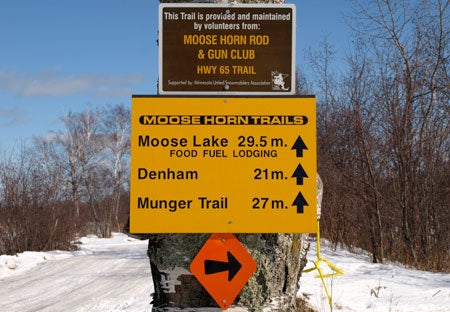 How do you know where you are or how to get anywhere? Clubs and groomer operators provide trail knowledge.
How do you know where you are or how to get anywhere? Clubs and groomer operators provide trail knowledge.So how does a club fund all this? Depending on the size of the club, money to purchase equipment could come from a variety of sources. Every state and province has a little different twist on how capital equipment is purchased. Some states will fund a portion of the groomer price if their grant application is approved. All snowbelt states in the lower Forty -Eight, through federal programs (i.e. Recreational Trails Program), offer purchase assistance for capital equipment. Here again it is through grant application. Both the state and federal grant application programs are very competitive to the point where many clubs will hire a grant writer to improve their chances of grant application approval. Secondary funding sources include club membership, monthly club dinners and the tried and true club raffles for snowmobiles and other merchandise give-aways.
The Equipment
Snowmobilers by nature are gear heads. So when it comes to grooming equipment it’s no surprise there is loyalty about brands and types of equipment. Whereas you have the black, yellow, red and blue crowd with snowmobiles, you have the blue, orange, red and yellow enthusiasts with groomer equipment.
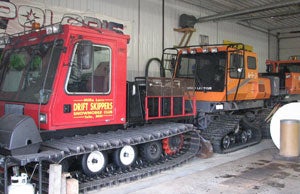 Clubs like the Mille Lacs Drift Skippers not only maintain a small fleet of groomers, but the club has to house them in a warm shop for service and storage.
Clubs like the Mille Lacs Drift Skippers not only maintain a small fleet of groomers, but the club has to house them in a warm shop for service and storage.Grooming equipment can be broken down into three basic types. There is the four-track mechanical type groomer or Tuckers (they’re orange in color). These are pretty simple in design and have a lot of characteristics similar to a 4-wheel drive truck with tracks. Their proponents like them from the standpoint of being easy to operate and work on.
Then you have the two-track units, which are, for the most part Bombardier (Yellow), Pisten Bully (Red) and Prinoth (Silver) product. These groomers are hydrostatic driven, very similar to a bulldozer or excavator. Hydrostatic groomers are purpose designed to groom snow. These units are more high tech in design, are pretty simple in maintenance and have several different driving configurations offered to the operator.
The third type of equipment is the farm tractor, Sur-Trac (Blue), Marcel (Red), Soucy (Track conversion kits for tractors), and Gilbert (Red or Green). They come in either two or four track application and, in certain snowbelt areas of the Midwest, may even be used as a normal farm tractor with tires only. The philosophy for tractor use is its pretty simple in application, and, in certain cases, can be converted back and forth from winter to summer use for year round application.
All grooming equipment types have plus and minus factors. Some applications work better in various snowbelt areas. Some brands and types have better service/parts distributions centers in their areas and will be a reason for a club to favor that brand. In all cases they do the one thing we all love and that’s make those trails nice and smooth for everyone to ride on!
Trail Etiquette
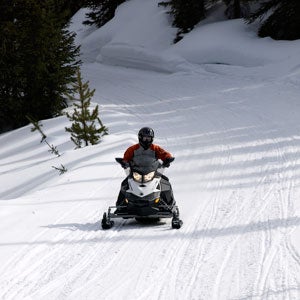 The next time you have a clean, smooth stretch of trail, say a “Thank You” to the clubs and trail groomers that maintain the heart of snowmobiling.
The next time you have a clean, smooth stretch of trail, say a “Thank You” to the clubs and trail groomers that maintain the heart of snowmobiling.Now that you have a little history and background on how the trail grooming business works, here are a few things to consider next time you’re out riding your favorite groomed trail. Grooming equipment operates at an average speed of 8-10 MPH. In most cases this is the perfect speed to “work” the snow and lay down a smooth finish. So remember if there are 50 miles to be groomed, that’s a 6-7 hour run or more for the operator.
Also consider that most grooming is done at night. This is done for a variety of reasons. First, it’s safer because of less traffic and second, colder temperatures at night help the trail surface to set up quicker. It takes around 3 hours (or longer) for a trail surface to “set up” after grooming. The longer the trail can remain untouched the harder and more durable the surface. So for all you sledders out there that like to “chase the groomer” at night, don’t! It’s very frustrating for the volunteer operator who sits in the groomer for long hours and looks in the mirror at a group of sleds that just tore up the trail he just groomed!
Finally, when you meet a groomer they ALWAYS have the right of way. These are big machines. You just can’t move a 6-ton groomer and a 2-ton drag around too easily.
So there you have it, everything you ever wondered about in regards to snowmobile trail grooming. Next time you’re out riding that manicured trail and meet a groomer, make sure to give them a break and thumbs up for the great job they do!
Editor’s Note: Al Cooper knows his snowmobiles and his grooming equipment. As an avid snowmobile enthusiast, he’s been involved with snowmobiling at either the dealer or manufacturer level since the mid-1970s until recently retiring as Sales Manager for Prinoth Trail Grooming equipment. He has worked with Yamaha, Ski-Doo, Bombardier Industrial, Camoplast and Prinoth trail grooming groups.



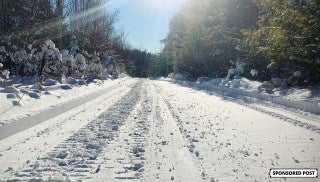
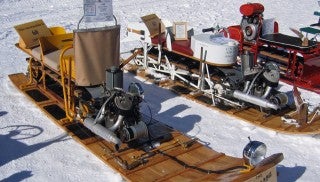
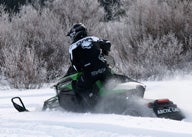


 Your Privacy Choices
Your Privacy Choices